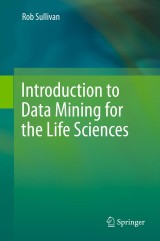Details

Introduction to Data Mining for the Life Sciences
|
213,99 € |
|
| Verlag: | Humana Press |
| Format: | |
| Veröffentl.: | 07.01.2012 |
| ISBN/EAN: | 9781597452908 |
| Sprache: | englisch |
| Anzahl Seiten: | 638 |
Dieses eBook enthält ein Wasserzeichen.
Beschreibungen
Data mining provides a set of new techniques to integrate, synthesize, and analyze tdata, uncovering the hidden patterns that exist within. Traditionally, techniques such as kernel learning methods, pattern recognition, and data mining, have been the domain of researchers in areas such as artificial intelligence, but leveraging these tools, techniques, and concepts against your data asset to identify problems early, understand interactions that exist and highlight previously unrealized relationships through the combination of these different disciplines can provide significant value for the investigator and her organization.
Introduction.- Fundamental Concepts.- Data Architecture and Data Modeling.- Representing Data Mining Results.- The Input Side of the Equation.- Statistical Methods.- Bayesian Statistics.- Machine Learning Techniques.- Classification and Prediction.- Informatics.- Systems Biology.- Let’s Call it a Day.- Appendix A.- Appendix B.- Appendix C. Appendix D.- Index.
<p>One of the major challenges for the scientific community, a challenge that has been seen in many business disciplines, is the exponential increase in data being generated by new experimental techniques and research. A single microarray experiment, for example, can generate thousands of data points that need to be analyzed, and this problem is predicted to increase. As new techniques in areas such as genomics and proteomics continue to be adopted into the mainstream as the costs fall, the need for effective mechanisms for synthesizing these disparate forms of data together for analysis is of paramount importance. But the sheer volume of data means that traditional techniques need to be augmented by approaches that elicit knowledge from the data, using automated procedures. </p>Data mining provides a set of such techniques, new techniques to integrate, synthesize, and analyze the data, uncovering the hidden patterns that exist within. Traditionally, techniques such as kernel learning methods, pattern recognition, and data mining, have been the domain of researchers in areas such as artificial intelligence, but leveraging these tools, techniques, and concepts against your data asset to identify problems early, understand interactions that exist and highlight previously unrealized relationships through the combination of these different disciplines can provide significant value for the investigator and her organization.
Data mining involves uncovering the patterns inherent within the data Provides a set of techniques that can help the life scientist leverage the valuable data asset With each set of techniques are tangible examples to support them Includes supplementary material: sn.pub/extras

















